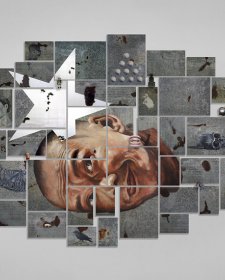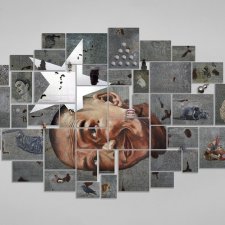He has frequently employed his own body as the medium by making casts of his face, hands and full body to negotiate the boundaries of self and within oneself.
Balasubramaniam's works have been exhibited around the world including at the Museum of Modern Art (MoMA), New York in 2010, Essel Museum, Austria (2009), Mori Art Museum, Japan (2008) and 1st Singapore Biennale (2006). His works are also currently on view in Sk(in), a solo exhibition at The Phillips Collection, Washington, DC. He lives and works in Bangalore, India.
Lifting the painted veil
Alwar Balasubramaniam on searching self-lessly...
‘Not everyone understands my work,’ says Alwar Balasubramaniam, somewhat gleefully. ‘They don’t have to,’ he concedes. As if to prove his point, Bala’s contributions for Beyond the Self show him off at his enigmatic best. Since this exhibition focuses on the self portrait, Bala has decided to leave himself out of the picture – well, almost. In one work, two white sheets of nearly blank paper are speckled with the tiniest crimson stains. Are they expressing the will of the artist through a Modernist-inspired composition? No. Are they dollops of paint, delineating where an image has yet to be fashioned? No. The title gives us a clue: Orifice 2008. It turns out that the little red dots – burnt-out holes – demarcate where the artist’s orifices would be if he were standing flush against the wall, leaning on the two sheets of paper. Looked at with this information, the work seems a most intimate form of self-representation: a trace of where Bala’s body has been. Now, the longer we gaze at it, the more of Bala we think we see. Might the crimson spots be fragile flecks of blood? Of course not.
Just as Orifice gestures to the gaps in the self, Bala’s other offerings document the telltale signs of its departure. In two versions of Gravity 2008 and 2009 we see fibreglass casts of the artist – well, almost. White fibreglass mock-ups of Bala’s features emerge unassumingly through white walls. We feel as if we are witnessing a subtle ghostly visitation. But, just as we think we have glimpsed his face and shoulders, taking slow shape before our eyes in Gravity 2009, we blink and lose our bearings: Bala seems to dissolve back into the sea of white from whence he came. Meanwhile, in Gravity 2008 the artist’s head appears to be encased in a snowy fold of canvas, its white weight tugging Bala towards the floor. Is his downward journey the result of gravity, a supernatural force or a symbol of his descent into the nether regions? Either way, the reason for his protracted plummet is invisible and the fibreglass Bala is nearly so. Yet, we think, if we can’t quite see him, perhaps he can hear us? In Silent sound 2009 a perfectly formed white ear protrudes from a wall. Is it Bala’s? But, the sculpture’s false partition holds out the equally false promise of an explanation. For the other side of the wall merely discloses a small hole. We know only one thing for sure: if we have any complaints about the artist’s refusal to reveal himself, they are going to fall on deaf ears.
Admittedly, Bala has not always been so elusive. An earlier work, Self in progress 2002, shows a white fibreglass cast of the artist sitting on a chair. The figure is only partly visible on one side of a wall, but he emerges purposefully through the other. In this work, the artist is present – even if he is in transit. However, Bala divulges that he changed tack in 2004. While, he used to be concerned with ‘casting space’, now he ‘casts the invisible’ instead. Untitled 2004 signposts this ‘about turn’ because it includes both types of ‘casting’. Here, two life-sized busts of Bala are safely ensconced in two transparent vitrines. Facing each other bravely, both torsos look solid and indestructible. Or, at least, they did – when first spied at Talwar Gallery, New York, during Bala’s solo, Into Thin Air in 2004. However, while one of them is made of sand and fibreglass, the other is composed of a mysterious ‘evaporating compound’. Somewhere behind the locked doors of a private collection, then, a replica of Bala is discreetly disappearing.
While delving into identity per se – especially the ins and outs of what constitutes ‘Indian identity’ – is an obsession with the subcontinent’s contemporary practitioners, Bala’s particular take on the issue is highly unusual. Unlike most others, Bala is not concerned with the historical and cultural moorings of the self in society. His primary preoccupation is with metaphysics. ‘Previous works were about perception, now my art is about what really exists ’ Bala explains. In an almost Buddhist gesture, he tracks the dissolution of individuality, its voyage into a deeper reality. Like footprints in the snow, Bala’s (invariably) white-on-white artworks are reminders of presence because they gesture to what is absent. ‘The self disappears in my work. I am not casting myself, just the outside of my body; where my body is not, is where it could be’ he muses about In, but out, 2005. Here, Bala’s silhouette is deeply embedded within a white wall. Viewed from one angle, the artist appears before us in three-dimensional form; from another and he has vanished. It is as if we have spied him in mid-journey – the split-second in which he crosses the threshold into another realm. We realise: Bala is travelling beyond the Self.
Zehra Jumabhoy
Steven and Elena Heinz Scholar at The Courtauld Institute of Art, London

















